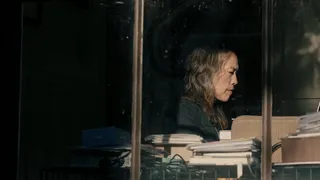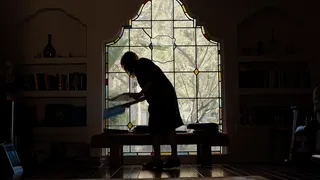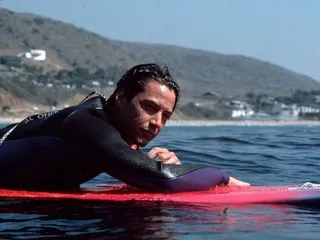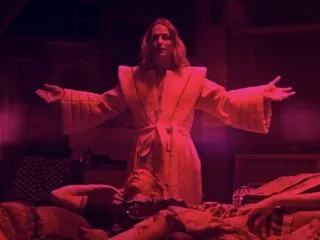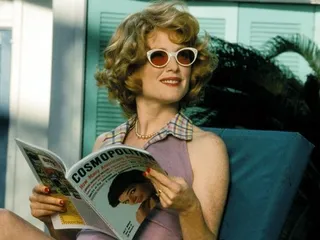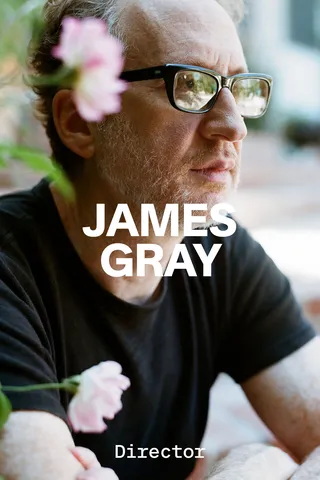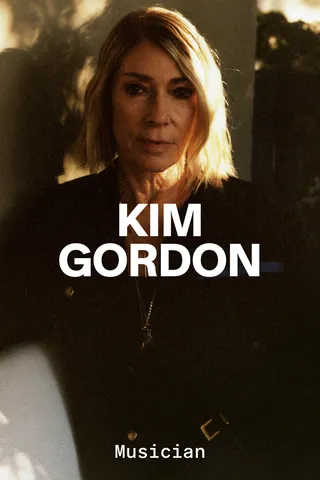Karyn Kusama
Director Karyn Kusama's feminist filmmaking is gutsy—not because her work (frequently in the horror genre) is full of gore, but because her movies speak directly to the challenges of summoning bravery as a woman in a world of brutality. Born in St. Louis in 1968 and based in Los Angeles, Kusama is best known for her late-aughts camp masterwork Jennifer’s Body, though her filmography is bookended by Girlfight, a raw portrait of a young female boxer, and 2018’s Destroyer, starring Nicole Kidman as a relentless L.A. detective. Mining kindred thematic territory, her work as pilot director on the hit series Yellowjackets (for which she’s also an executive producer) earned her an Emmy nomination in 2022. Kusama’s hardy heroines—even at their most heightened or panicked—never lose their grit or humanity for long, leaving viewers hungry for more.
A personal message
my Film List
Click each title to discover our curator’s notes and where to watch
This is a tragic love story from one of cinema’s most swoon-worthy stylists. Perhaps less well-known than Ophüls’s other films, like La Ronde or The Earrings of Madame De…, it is nevertheless one of his most grimly operatic love stories, both fulfilling its promise as a “woman’s picture” while also critiquing the devastating cost of female sacrifice within traditional romances. The conceit is almost absurd: A young woman (played across many decades by Joan Fontaine) falls hopelessly in love with her dashing playboy neighbor (played with rakish charm by Louis Jourdan). Over many years their paths cross and cross yet again—and each time he forgets that he’s met her before. The film pulls back the curtain on male chivalry and female devotion, revealing both to be largely no-win exercises in self-deception.
{{ All Items }}A crime drama with the perfect genre premise in my opinion: A rich manufacturing magnate’s son is kidnapped—but early on he learns the kidnapped boy is not his son; he’s his chauffeur’s son. This central moral question—would the man pay a huge ransom for someone else’s son?—engages the viewer in considering what real strength, and real wealth, actually look like. This movie (half of which takes place in one location) still teaches me about framing, composition and purity of vision. High and Low is Kurosawa’s perfect movie.
{{ All Items }}I believe this is one of the greatest films of the modern era, and I think it endures for a reason. I have to separate myself from Polanski the man and just watch and absorb the film, because I experience it as a feminist statement about the price women pay to be aligned with ambitious men. It’s complex and jarring to know that this film was made by a person whose criminal history is what it is. But I just have to believe that in seeing a film so closely entwined with our heroine’s experience of evil, I’ve gotten a window into Polanksi’s humanity, too, which is part of what great art can do.
{{ All Items }}I saw this in my twenties, and it was formative because it’s such a queer statement. Before taking some very dark narrative turns, the film is such an incredibly crazy, colorful, wild movie. It’s fizzy, poppy and then extremely disturbing. I appreciate the strange alchemy of this movie—it’s both completely absurd and then very weirdly real—and it’s a great example of the kind of “tonal mash-up” movies that have shaped some of my own filmmaking.
{{ All Items }}Michael Ritchie is an unsung hero of American filmmaking who has made many, many consequential movies, and this is one of his most affectionate films, sharing a generosity of spirit with his losing-team baseball comedy-drama, The Bad News Bears. Smile focuses on a Young American Miss beauty pageant in Santa Rosa, California, and explores a world of hustlers, ingenues and frustrated artists, all looking for a moment of recognition. Shot by Conrad Hall, the film has an unforced beauty in its design and costuming, and it features incredible performances from Bruce Dern, Barbara Feldon, Annette O’Toole, Joan Prather and a young Melanie Griffith. It's one of those movies that looks really easy, with its casual humor and biting social satire, but the craft and thoughtfulness behind the camera packs an unexpected wallop.
{{ All Items }}I’d describe this as a three-hour domestic epic, in which a dutiful mother cares for a son who could look after himself but chooses not to. You watch her take care of him and her house, cooking and cleaning, until one day her routine is broken. All of that could sound kind of uninteresting, but the experience of watching the movie is gripping and the filmmaking—the image-making and the performances—is subtle and completely lived-in. It took such incredible confidence and a definite ‘“fuck you” attitude from Chantal Akerman to make this movie (and at the tender age of only 25, no less!). She was a radical and a renegade who we’ll all continue to learn from.
{{ All Items }}I have a very vivid memory of seeing The Parallax View for the first time as a lonely teenager and not quite understanding it beyond the blazing star power of Warren Beatty and the undeniable beauty of Gordon Willis’s cinematography. Now I see how incredibly merciless it is as a depiction of a diluted faith in American institutions—unsparing, uncompromising and leaving you with more questions than answers. One of the most urgently relevant paranoid thrillers ever made.
I’ve probably seen Reds 20 times. It has an incredible sense of scope and detail in the design and cinematography and features performances from movie stars like Warren Beatty (also the film’s director), Diane Keaton and Jack Nicholson at the height of their charismatic powers. Weaving interviews with real-life subjects of the early-20th-century socialist movement within its fictionalized portrait of American Communist John Reed, Reds remains a fascinating snapshot of progressive politics in the United States.
{{ All Items }}An old-school political melodrama from one of my favorite directors of all time, with Sigourney Weaver and Mel Gibson exuding some major movie-star vibes. Set in 1960s Indonesia, the film’s surface seems to vibrate with color, texture and heat, and it’s just one example of Peter Weir’s versatility and formal nimbleness as a filmmaker.
{{ All Items }}A great love story that for a young teenage me was so deeply romantic: It’s about a punk rock guy from the wrong side of town and a perfect Valley girl falling in love. My hopes and dreams were seen by that movie, as our heroine, Julie, is revealed to be a weirdo in her own right. It’s also got a killer soundtrack, plus beautiful, bright, poppy ’80s visuals, and best of all, the performances are so good, so funny and so affectionate. The fact that this movie was directed by a woman offered me cultural permission to pursue filmmaking. And who could deny Nicolas Cage at his most crushable?
{{ All Items }}Come and See is a peerless depiction of World War II, both hallucinatory and dreamlike but also communicating how horribly mundane war can be. The visual and sonic storytelling is so memorable: We start with two young boys looking for firearms buried in sand, so that they can use them to enlist in the Soviet partisan army–yet when they speak, they have the gravelly voices of men. If we take the theory that movies are dreams come to life, then this film is a nightmare of harrowing authenticity. It’s really rare to see a movie so powerful.
{{ All Items }}This has so much visual confidence, so much lushness and so much personality in the filmmaking. It’s a mash-up of a vampire movie and a Western, but with a uniquely contemporary feel. There are great performances from Bill Paxton, Lance Henriksen and Jenette Goldstein—actors I’ve loved over the years—so much so that I went on to work with Lance in Jennifer’s Body. Kathryn Bigelow’s film is funny, dark and gripping, and she set the stage for people like me, who want to make movies that ride the lines of a bunch of different genres.
{{ All Items }}Imagine brilliant twin brothers, both gynecologists with a thriving practice, both slowly tilting toward psychopathy: I mean, really, is there a more nightmarish scenario for a woman than this? David Cronenberg manages to take this queasy concept in 1988’s Dead Ringers and infuse it with all the bodily dread and terror you might expect from the master filmmaker, along with surprising jolts of heartbreak and even a kind of lunatic wit. Jeremy Irons’s dual performance as Beverly and Elliot Mantle—surely one of the towering achievements of the modern acting canon—is by turns callous and dashing, vulnerable and stricken. As both characters descend into drug addiction and madness, the film reaches an unforgettable level of Grand Guignol theater. A treatise on the ultimately self-annihilating power of narcissism, Dead Ringers remains one of Cronenberg’s most truly disturbing films.
{{ All Items }}This is a portrait of Janet Frame, an artist and writer beloved in New Zealand. Jane Campion immerses us in Frame’s sensory experience of the world so that we understand her desire and need to make art. There is such sensitivity in the filmmaking, as well as the occasional sense of peril that we feel for Frame, played by Kerry Fox. We see how close she came to being discarded and how much strength it took for her to find her artist’s voice. It’s a beautiful story.
{{ All Items }}Few movies, and even fewer movie stars, are as insanely watchable as Keanu Reeves is in Kathryn Bigelow’s pop-action masterpiece Point Break. About a gang of bank-robbing surfers infiltrated by Reeves’s undercover agent Johnny Utah (yes, that is his name), the film includes still-peerless action sequences, a very healthy sense of humor about itself, and a shrewd, rangy turn from Patrick Swayze as the charismatic criminal in charge. Alongside great supporting work by Lori Petty and Gary Busey, the movie remains a gleaming showcase for the magic of its lead actor: Natural, goofily alive and almost unbearably beautiful to look at, Reeves incinerates the screen with his genuinely unique star power. This movie is pure pleasure, and the world needs more like it.
{{ All Items }}Few films have remained as mysterious and generative as Safe has for me. Sly, scary and filled with dread, it plays as much as a horror film as it does a domestic drama. In telling the story of an “ordinary” woman who finds herself allergic to the world, Todd Haynes digs into some of our most uncomfortable existential questions. It’s a chilly, supremely confident film from a director who’s flexing every muscle at his disposal.
{{ All Items }}Velvet Goldmine is a fantasia of sound, music, bold costuming, and meticulously designed makeup and hair styling—a joyously explicit depiction of artifice. If Safe examines deceptive artifice, or the artifice of wealth and health, then Velvet Goldmine is about the fantasy of performance and the delusions around one’s own image and one’s own narrative. I saw this movie at least 10 times in the theater. Like an addiction, I had to see it over and over again on the big screen. I loved every transition, every hard and difficult thing about it, and was completely swept away by its dreamlike logic.
{{ All Items }}A masterwork from one of film’s most adventurous storytellers, Beau Travail is Claire Denis’s loose reworking of Herman Melville’s Billy Budd set among French Foreign Legion soldiers in modern-day Djibouti. As bold and surreally ravishing as a film can get, it also features what I would define as one of the greatest endings of all time. The ending continues to teach me about the sorcery of cinema.
{{ All Items }}Together is a beautiful family drama about the trials and tribulations within a 1970s commune in Sweden, marked by effortless filmmaking and vividly drawn characters. It looks and feels really casual, almost like cinéma verité, but by the end the story hits you with heart-stopping force. Brick by brick, Moodysson lays the groundwork for all these relationships, and the result is joyous, funny and life-affirming.
{{ All Items }}Jacques Audiard just has an interesting way of seeing things, and A Prophet is my favorite of his broad and varied body of work. You feel like you’re watching a person grow up before your very eyes in this prison saga, and to have that maturity evolve behind bars is a metaphor for the ages. The performances are beautifully naturalistic, yet there’s such rigor and discipline in the filmmaking. This film just blows me away.
{{ All Items }}Watching this stunning film, I feel I’m listening to a voice that has been given total realization and articulation. Tilda Swinton, who plays the Russian wife of an Italian industrialist, struggles with a forbidden love. These kinds of stories can easily become neo-noirs that only end in tragedy, and while I Am Love traffics in that narrative territory, it also upends it, achieving something quieter and more radical in its meaning.
{{ All Items }}Mandy is the kind of movie I relish: thematically complex, visually gonzo and secretly very, very political. The first half of the movie explores the titular character (played with astonishing depth by Andrea Riseborough) as she shares an idyllic love with Red (Nicolas Cage, at his most wild and layered). Their lives are upended by cosmic catastrophe when Mandy is kidnapped by a demented cult whose leader—like most cult leaders—happens to be just another delusional man whose biggest fear is to be laughed at. What follows is tragic and insane, but I’m genuinely moved by this nightmarish, phantasmagoric vision of the defiled Female. There’s a reason this film is called Mandy: Her looming presence, and agonizing absence, are the soul of the movie.
{{ All Items }}
“If you’re the director, you’re in the hot seat, and you feel like no one has more to lose than you. ”
MY CREATIVE PROCESS
Exploring craft and influence
RELATED MATERIAL
Essays, interviews and other connections
![The Point Break Exception]() The Point Break Exceptionread
The Point Break ExceptionreadOne surfing film rides high above all the others. What is the key to its awesomeness?
By Thad Ziolkowski
![On Drugs]() On Drugsread
On DrugsreadThe author of Fuccboi retreats to a cabin with beers and gummies to more deeply experience films about states of inebriation (and love and grief)
By Sean Thor Conroe
![Todd Haynes: Backward Glances]() Todd Haynes: Backward Glancesread
Todd Haynes: Backward GlancesreadThe auteur explains his attraction to classic films, where slick surfaces and strict social codes conceal teeming complexities
By Stephanie Bunbury
